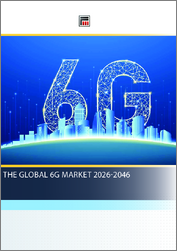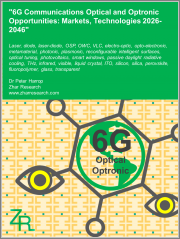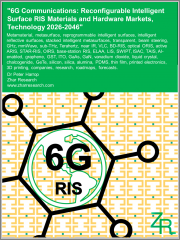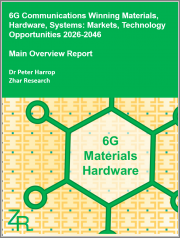
|
시장보고서
상품코드
1565350
세계의 RIS(Reconfigurable Intelligent Surface) 시장(2025-2035년)The Global Market for Reconfigurable Intelligent Surfaces (RIS) 2025-2035 |
||||||
RIS는 IRS(Intelligent Reflecting Surface) 또는 소프트웨어 제어 메타표면이라고도 하며, 전자파를 조작하기 위해 전자적으로 제어할 수 있는 수많은 작은 수동 소자로 구성된 인공 구조물입니다. 이 표면은 수신 신호를 원하는 방향으로 반사, 굴절, 흡수, 집중시킬 수 있어 무선 전파 환경을 효과적으로 형성할 수 있습니다. 최근 메타물질의 발전으로 RIS는 미래 6G 무선통신의 유망한 기술로 떠오르고 있습니다. 높은 어레이 이득, 저비용, 저전력 소비의 장점을 가진 RIS는 신호 커버리지를 크게 확장하고 시스템 처리 능력을 향상시키며 에너지 효율을 향상시킬 것으로 예상됩니다.
RIS 기술은 무선 네트워크의 커버리지, 처리 능력, 에너지 효율을 향상시킬 수 있는 획기적인 전자기파 조작 능력을 제공하며, 5G 네트워크가 확장되고 6G 개발이 가속화됨에 따라 RIS는 무선 통신의 현재 한계를 극복하는 데 중요한 역할을 할 것으로 예상됩니다. 중요한 역할을 할 것으로 예상됩니다. 주요 응용 분야는 통신, 스마트시티, 산업용 IoT, 의료, 자동차, 항공우주, 소비자 가전 등 다양합니다. 고속 및 저지연 통신에 대한 수요 증가, IoT 도입 확대, 에너지 효율적인 무선 솔루션에 대한 요구가 시장을 주도하고 있습니다. 그러나 높은 초기 비용, 대규모 구축에 따른 기술적 복잡성, 표준화 문제 등이 문제점으로 지적되고 있습니다.
세계 RIS(Reconfigurable Intelligent Surface) 시장에 대해 조사 분석했으며, 시장 규모와 성장 전망, 기술 상세 정보, 응용 분야, 경쟁 구도, 향후 전망 등의 정보를 전해드립니다.
목차
제1장 주요 요약
- RIS(Reconfigurable Intelligent Surface) 개요
- 주요 시장 성장 촉진요인과 과제
- 기술과 시장 동향
- RIS의 열쇠가 되는 메타물질
- 시장 규모와 성장 예측
- 경쟁 구도 개요
- 향후 전망과 기회
제2장 서론
- 기술 개요
- 시스템 아키텍처
- 현대 무선통신의 중요성
- 기존 무선 기술과 비교한 이점
- 현재 제한과 과제
- 기타 스마트 전자(EM) 디바이스와의 비교
제3장 RIS 기술
- Reconfigurable Intelligent Surface
- LCD-based RIS
- MEMS-based RIS
- Varactor Diode-based RIS
- PIN Diode-based RIS
- 기타 재료
- RIS 기술 비교
제4장 무선통신 시스템 리스크
- 5G
- 6G 이후
- MIMO 시스템과 RIS
- 빔포밍과 RIS
- 무선 네트워크 에너지 효율
제5장 시장과 용도
- 통신
- 스마트 시티 및 IoT
- 산업용 IoT 및 인더스트리 4.0
- 의료 용도
- 자동차 및 운송
- 항공우주 및 방위
- 스마트홈 및 소비자 일렉트로닉스
제6장 시장 분석과 동향
- 세계 시장 규모와 성장 예측
- 시장 세분화 : 기술별
- 시장 세분화 : 시장별
- 시장 세분화 : 지역별
- 주요 시장 성장 촉진요인
- 시장이 해결해야 할 과제와 장벽
- 신흥 시장 기회
- 향후 전망
제7장 표준화와 규제 환경
- RIS에 관련된 현재 표준
- 주파수 할당과 관리
제8장 환경과 지속가능성에 관한 고려
- RIS 대응 네트워크 에너지 효율
- RIS 기술 수명주기 평가
- 전자 폐기물 관리와 재활용
- 지속가능한 생산 방식
- 스마트 그리드와 에너지 관리에서 RIS의 역할
- 대규모 RIS 전개 환경에 대한 영향
제9장 과제와 한계
- RIS 구현의 기술적 과제
- 생산 규모 확대와 비용 절감
- 기존 인프라와의 통합
- 복잡한 환경에서의 퍼포먼스
- 보안과 프라이버시에 관한 우려
제10장 기업 개요(기업 20개사 개요)
제11장 부록
제12장 참고 문헌
LSH 24.11.12RIS, also known as Intelligent Reflecting Surfaces (IRS) or software-controlled metasurfaces, are artificial structures composed of a large number of small, passive elements that can be electronically controlled to manipulate electromagnetic waves. These surfaces can reflect, refract, absorb, or focus incoming signals in desired directions, effectively shaping the wireless propagation environment. Due to recent advances in metamaterials, Reconfigurable Intelligent Surface (RIS) has emerged as a promising technology for future 6G wireless communications. Benefiting from its high array gain, low cost, and low power consumption, RISs are expected to greatly enlarge signal coverage, improve system capacity, and increase energy efficiency.
RIS technology offers revolutionary capabilities in manipulating electromagnetic waves, enabling enhanced coverage, capacity, and energy efficiency in wireless networks. As 5G networks expand and 6G development accelerates, RIS is expected to play a crucial role in overcoming current limitations in wireless communications. Key applications span telecommunications, smart cities, Industrial IoT, healthcare, automotive, aerospace, and consumer electronics. The market is driven by increasing demand for high-speed, low-latency communications, growth in IoT adoption, and the need for energy-efficient wireless solutions. However, challenges include high initial costs, technical complexities in large-scale deployment, and standardization issues.
Report contents include:
- Market Size and Growth Projections: Detailed forecasts of the RIS market size and growth rate from 2025 to 2035, segmented by technology type, application, and geography.
- Technology Deep Dive: Comprehensive analysis of various RIS technologies, including metasurfaces, liquid crystal-based RIS, MEMS-based RIS, and emerging approaches.
- Application Landscape:Exploration of key application areas such as 5G/6G networks, IoT, smart cities, autonomous vehicles, and aerospace communications.
- Competitive Landscape: Profiles of leading companies and emerging players in the RIS space, including their technologies, strategies, and market positioning. Companies profiled include Alcan Systems, Alphacore Inc., Edgehog Advanced Technologies, Evolv Technologies Inc., Fractal Antenna Systems Inc., Greenerwave, Huawei, Kymeta Corporation, Leadoptik Inc., Lumotive, META, Metaboards Limited, Metawave Corporation, Nokia, NTT DOCOMO, Pivotal Commware Inc., SK Telecom, Teraview Limited, and ZTE Corporation.
- Future Outlook: Assessment of emerging trends, potential disruptions, and long-term prospects for RIS technology.
- Developments in RIS technology, including:
- Integration with AI and machine learning for adaptive control
- Quantum RIS concepts pushing the boundaries of performance
- Self-configuring and self-healing RIS for enhanced reliability
- Holographic radio and terahertz communications enabled by RIS
- Market Drivers and Opportunities
- Challenges and Market Dynamics
- Technology Benchmarking and Performance Analysis
- Comprehensive comparison of different RIS technologies.
- Integration with Wireless Communication Systems.
- Environmental and Sustainability Considerations.
- Standardization and Regulatory Landscape.
TABLE OF CONTENTS
1. EXECUTIVE SUMMARY
- 1.1. Overview of Reconfigurable Intelligent Surfaces (RIS)
- 1.2. Key Market Drivers and Challenges
- 1.3. Technology and Market Trends
- 1.4. Metamaterials key to RIS
- 1.5. Market Size and Growth Projections
- 1.6. Competitive Landscape Overview
- 1.7. Future Outlook and Opportunities
2. INTRODUCTION
- 2.1. Technology overview
- 2.1.1. Key features and functionality
- 2.1.2. Frequencies
- 2.1.3. Physics of Electromagnetic Wave Manipulation
- 2.1.3.1. Reflection
- 2.1.3.2. Refraction
- 2.1.3.3. Diffraction
- 2.1.3.4. Absorption
- 2.1.4. RIS Operating Principles
- 2.1.4.1. Passive RIS
- 2.1.4.2. Active RIS
- 2.1.4.3. Hybrid RIS
- 2.1.5. Key Performance Parameters
- 2.1.5.1. Reflection Coefficient
- 2.1.5.2. Phase Shift Range
- 2.1.5.3. Bandwidth
- 2.1.5.4. Power Consumption
- 2.1.5.5. Reconfiguration Speed
- 2.1.6. Design Considerations for RIS
- 2.1.6.1. Surface Element Design
- 2.1.6.2. Array Configuration
- 2.1.6.3. Control Mechanisms
- 2.1.6.4. Integration with Existing Infrastructure
- 2.2. System Architecture
- 2.3. Importance in Modern Wireless Communications
- 2.4. Advantages Over Traditional Wireless Technologies
- 2.5. Current Limitations and Challenges
- 2.6. Comparison with Other Smart Electromagnetic (EM) Devices
3. RIS TECHNOLOGIES
- 3.1. Metasurfaces
- 3.1.1. Principles of Metasurfaces
- 3.1.2. Types of Metasurfaces
- 3.1.2.1. Meta-Lens
- 3.1.2.2. Metasurface holograms
- 3.1.2.3. Flexible metasurfaces
- 3.1.3. Fabrication Techniques
- 3.1.4. Characteristics
- 3.2. Liquid Crystal-based RIS
- 3.2.1. Operating Principles
- 3.2.2. Advantages and Limitations
- 3.3. MEMS-based RIS
- 3.3.1. MEMS Technology Overview
- 3.3.2. Design and Fabrication
- 3.3.3. Performance Metrics
- 3.4. Varactor Diode-based RIS
- 3.4.1. Overview
- 3.5. PIN Diode-based RIS
- 3.5.1. Overview
- 3.6. Other Materials
- 3.6.1. Ferroelectric materials
- 3.6.2. Phase Change Materials
- 3.6.3. Graphene
- 3.7. Comparison of RIS Technologies
- 3.7.1. Performance Metrics
- 3.7.2. Cost Analysis
- 3.7.3. Scalability and Manufacturing Considerations
4. RIS IN WIRELESS COMMUNICATION SYSTEMS
- 4.1. 5G
- 4.1.1. Overview
- 4.1.2. Market drivers
- 4.1.2.1. Coverage Enhancement Needs
- 4.1.2.2. Energy Efficiency Requirements
- 4.1.2.3. Capacity Improvement Demands
- 4.1.2.4. Cost Optimization Goals
- 4.1.3. Applications
- 4.1.4. RIS operation phases
- 4.1.5. Functionalities of RIS
- 4.1.6. RIS prototypes
- 4.1.7. 5G Network Requirements
- 4.1.8. RIS Role in 5G Infrastructure
- 4.1.9. Integration with 5G Networks
- 4.1.9.1. Network Integration Strategies
- 4.1.9.2. Channel Modeling
- 4.1.9.3. Signal Processing
- 4.1.9.4. Integration Challenges and Solutions
- 4.1.10. Performance Enhancement
- 4.1.10.1. Coverage Optimization
- 4.1.10.2. Capacity Enhancement
- 4.1.10.3. Energy Efficiency
- 4.1.11. Advanced Applications
- 4.1.11.1. mmWave Communications
- 4.1.11.2. Massive MIMO Systems
- 4.1.11.3. IoT Applications
- 4.1.12. Implementation Challenges
- 4.1.12.1. Technical Challenges
- 4.1.12.2. Standardization
- 4.1.13. Future Directions
- 4.1.13.1. Hardware Advancements
- 4.1.13.2. Control Systems
- 4.1.13.3. Integration Capabilities
- 4.1.13.4. Performance Enhancement
- 4.1.14. Market and technology roadmap
- 4.2. 6G and Beyond
- 4.2.1. 6G Reconfigurable intelligent surfaces and metamaterials opportunities
- 4.2.2. RIS materials applications
- 4.2.3. RIS costs in volume
- 4.2.4. RIS formulations
- 4.2.5. RIS in Terahertz Communications
- 4.2.6. Holographic Radio
- 4.2.7. Intelligent Reflecting Surfaces for Satellite Communications
- 4.3. MIMO Systems and RIS
- 4.3.1. RIS-assisted MIMO
- 4.3.2. RIS-based Massive MIMO
- 4.3.3. Performance Enhancements and Challenges
- 4.4. Beamforming and RIS
- 4.4.1. Passive Beamforming
- 4.4.2. Hybrid Beamforming with RIS
- 4.4.3. Adaptive Beamforming Techniques
- 4.5. Energy Efficiency in Wireless Networks
- 4.5.1. RIS for Green Communications
- 4.5.2. Energy Harvesting with RIS
5. MARKET AND APPLICATIONS
- 5.1. Telecommunications
- 5.1.1. Coverage Enhancement
- 5.1.2. Capacity Improvement
- 5.1.3. Interference Mitigation
- 5.1.4. Market forecast
- 5.2. Smart Cities and IoT
- 5.2.1. Urban Environment Monitoring
- 5.2.2. Smart Transportation Systems
- 5.2.3. Energy Management in Buildings
- 5.2.4. Market forecast
- 5.3. Industrial IoT and Industry 4.0
- 5.3.1. Factory Automation
- 5.3.2. Warehouse Management
- 5.3.3. Process Control and Monitoring
- 5.3.4. Market forecast
- 5.4. Healthcare and Medical Applications
- 5.4.1. Wireless Body Area Networks
- 5.4.2. Remote Patient Monitoring
- 5.4.3. Medical Imaging Enhancement
- 5.4.4. Market forecast
- 5.5. Automotive and Transportation
- 5.5.1. Vehicle-to-Everything (V2X) Communications
- 5.5.2. Autonomous Vehicles
- 5.5.3. Intelligent Transportation Systems
- 5.5.4. Market forecast (IoT)
- 5.6. Aerospace and Defense
- 5.6.1. Radar Systems Enhancement
- 5.6.2. Secure Communications
- 5.6.3. Stealth Technology
- 5.6.4. UAVs
- 5.7. Smart Home and Consumer Electronics
- 5.7.1. In-home Wireless Coverage Optimization
- 5.7.2. Device-to-Device Communications
- 5.7.3. Augmented and Virtual Reality Applications
6. MARKET ANALYSIS AND TRENDS
- 6.1. Global Market Size and Growth Projections
- 6.1.1. Market Segmentation by Technology
- 6.1.2. Market Segmentation by Market
- 6.1.3. Market Segmentation by Geography
- 6.2. Key Market Drivers
- 6.2.1. Increasing Demand for High-Speed, Low-Latency Communications
- 6.2.2. Growth in IoT and Smart Device Adoption
- 6.2.3. Advancements in 5G and 6G Technologies
- 6.2.4. Need for Energy-Efficient Wireless Solutions
- 6.2.5. Other drivers
- 6.3. Market Challenges and Barriers
- 6.3.1. High Initial Implementation Costs
- 6.3.2. Technical Complexities in Large-Scale Deployment
- 6.3.3. Standardization and Interoperability Issues
- 6.3.4. Regulatory and Compliance Challenges
- 6.3.5. Other challenges and barriers
- 6.4. Emerging Market Opportunities
- 6.4.1. Integration with Edge Computing
- 6.4.2. RIS for Satellite and Space Communications
- 6.4.3. Advanced Materials for RIS
- 6.4.4. AI and Machine Learning Integration
- 6.4.5. Quantum RIS Concepts
- 6.4.6. Cognitive RIS
- 6.4.7. Self-configuring and Self-healing RIS
- 6.4.8. Integration with Blockchain for Secure Communications
- 6.5. Future Outlook
- 6.5.1. RIS in 6G and Beyond
- 6.5.2. Holographic Communications
- 6.5.3. Space-based RIS Networks
- 6.5.4. AI and Machine Learning in RIS Control
- 6.5.5. RIS for Terahertz and Optical Wireless Communications
- 6.5.6. Biological and Health Implications of Large-Scale RIS Deployment
7. STANDARDIZATION AND REGULATORY ENVIRONMENT
- 7.1. Current Standards Related to RIS
- 7.1.1. IEEE Standards
- 7.1.2. 3GPP Specifications
- 7.1.3. ETSI Standards
- 7.2. Spectrum Allocation and Management
- 7.2.1. Safety and Electromagnetic Compatibility Regulations
- 7.2.2. Data Privacy and Security Considerations
8. ENVIRONMENTAL AND SUSTAINABILITY CONSIDERATIONS
- 8.1. Energy Efficiency of RIS-enabled Networks
- 8.2. Life Cycle Assessment of RIS Technologies
- 8.3. E-waste Management and Recycling
- 8.4. Sustainable Manufacturing Practices
- 8.5. RIS Role in Smart Grid and Energy Management
- 8.6. Environmental Impact of Large-Scale RIS Deployment
9. CHALLENGES AND LIMITATIONS
- 9.1. Technical Challenges in RIS Implementation
- 9.2. Scaling Up Production and Cost Reduction
- 9.3. Integration with Existing Infrastructure
- 9.4. Performance in Complex Environments
- 9.5. Security and Privacy Concerns
10. COMPANY PROFILES (20 company profiles)
11. APPENDICES
- 11.1. Glossary of Terms
- 11.2. List of Abbreviations
- 11.3. Research Methodology



















